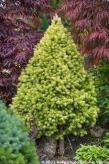Picea glauca 'RAINBOW'S END'

Picea glauca 'RAINBOW'S END'
dwarf white spruce
dwarf white spruce
| SIZE/TYPE | medium-sized shrub |
|---|---|
| USUAL HEIGHT | 1.5-2.5m |
| USUAL WIDTH | 1-1.5m |
| LEAVES | evergreen conifer |
| COLOUR OF LEAVES |
 + + multicoloured:blue-green and cream multicoloured:blue-green and cream |
| FLOWERS | insignificant or non-blooming |
| LOCATION | full sun |
| USDA zone (lowest) | 3 (down to -40°C) |
| WINTER PROTECTION | |
| FOR ZONE 5+6 |

|
| FOR ZONE 7 |

|
| BELONGS TO CATEGORIES | Conifers |
White spruce is a North American species whose other name Alberta spruce aptly honours its origin. It belongs among the hardiest spruce species with distribution up north to the Arctic Ocean. The species is a very tall tree reaching 30 meters in height, rarely more, but in Europe it is smaller and rarely cultivated. It used to be a popular Christmas trees while spruce was in fashion, but Europe has plenty of its native spruce species, and in the new millennium, fir trees with non-prickly and glossy needles have overwhelmed the Christmas trees market. However, there are attractive forms of white spruce, often dwarf, especially the albertiana variety, which was discovered at the turn of 19th and 20th century in Alberta, Canada, as a witch’s broom and introduced in 1903 named Conica. Since then, several varieties of different needle colour and habit, mostly of low growth, have been developed.
Rainbow’s End is a popular variety of dwarf white spruce. It grows slower than Conica spruce and makes bright beige new growths in spring, while their second flush in midsummer is almost golden yellow. Very pretty plant that will glow like a beacon in any border.
Conical varieties of white spruce, more than the vigorously growing species and varieties, can be prone to spruce needle cast (Lophodermium piceae), a fungus which attacks the needles which eventually dry up and fall off. This usually happens in somewhat weakened plants, and if you detect drying of needles and twigs, treat your plant with a recommended spray against fungal diseases, and at the same time adjust the growing conditions of the tree - check the soil humidity and add nutrition. A more common problem, especially when the plant is too dry or over-fertilized with nitrogen-based fertilizers, are the spruce spider mites, which suck on needles which also dry up and fall off. You will recognize this infestation by cobwebs on the plant used by the mites as highways. Again, use a recommended solution against mites and adjust growing conditions.
Dwarf white spruce is not very demanding as to soil type, but it does not like extremes, i.e., neither too wet nor too dry. It does best in gardens with fertile soil and even moisture, preferably in full sun, but it can also handle filtered sunlight or light shade for a part of the day. It is a beautiful container plant that is hardy enough to stand outside on a patio or balcony all year round. Hardy to about -40°C (USDA zone 3).
Last update 07-01-2013; 26-12-2023
Rainbow’s End is a popular variety of dwarf white spruce. It grows slower than Conica spruce and makes bright beige new growths in spring, while their second flush in midsummer is almost golden yellow. Very pretty plant that will glow like a beacon in any border.
Conical varieties of white spruce, more than the vigorously growing species and varieties, can be prone to spruce needle cast (Lophodermium piceae), a fungus which attacks the needles which eventually dry up and fall off. This usually happens in somewhat weakened plants, and if you detect drying of needles and twigs, treat your plant with a recommended spray against fungal diseases, and at the same time adjust the growing conditions of the tree - check the soil humidity and add nutrition. A more common problem, especially when the plant is too dry or over-fertilized with nitrogen-based fertilizers, are the spruce spider mites, which suck on needles which also dry up and fall off. You will recognize this infestation by cobwebs on the plant used by the mites as highways. Again, use a recommended solution against mites and adjust growing conditions.
Dwarf white spruce is not very demanding as to soil type, but it does not like extremes, i.e., neither too wet nor too dry. It does best in gardens with fertile soil and even moisture, preferably in full sun, but it can also handle filtered sunlight or light shade for a part of the day. It is a beautiful container plant that is hardy enough to stand outside on a patio or balcony all year round. Hardy to about -40°C (USDA zone 3).
Last update 07-01-2013; 26-12-2023
SIZES and PRICES
CURRENTLY SOLD OUT
GLOSSARY
|










